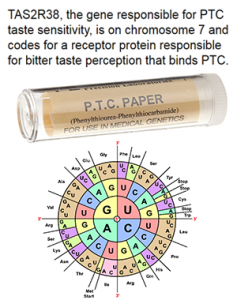
Natural phenomena are observable events that inspire questions and curiosity in students. The NGSS suggests using anchoring phenomenon as ways to engage students in lessons. When I plan lessons, I try to locate phenomena that can be observable and interesting. When dealing with molecular biology, younger students tend to have trouble connecting the concepts to their own experiences.
I start my lecture slides on DNA with an anchoring phenomenon on PTC and taste testing. PTC, or phenylthiocarbamide, is a chemical that tastes bitter to some people but is tasteless to others. It is sold as genetic taste strips by Amazon and biological supply companies.
The ability to taste PTC is a dominant trait so many members of the class will experience a bitter taste. Homozygotes (AA) may report a very strong bitter taste and heterozygotes may not have as strong of a response. Environmental factors may also influence the ability to taste PTC. For a more nuanced explanation of the gene, check out “Myths of Genetics.”
Lesson Structure and Activities
The lesson starts with the anchor question/phenomenon: “How do small changes in DNA lead to big changes in traits?” I try to make something simple for freshman that was also tangible, like the ability to taste. I usually present this topic after Mendelian genetics, so they do understand recessive traits and inheritance patterns.
Throughout the lecture and activities, we continually refer to the original phenomenon, showing how SNPs (single nucleotide polymorphisms) can be used to establish variations in phenotypes. For example, for tasters and non-tasters:
PAV (taster) = C C A G C T G T C
AVI (nontaster) = G C A G T T A T C
Students can compare both variants to show how tasters have a sequence that allows them to build the receptor protein that binds to PTC. Snpedia also provides additional information about the SNP associated with the trait.

Students can also do a follow-up activity that looks at SNPs that control the curly hair of dogs. This activity was developed from HHMI Activity: Mapping Genes to Traits, though I shorted it quite a bit to be able to complete in 15-20 minutes.
Students can then complete the DNA coloring as independent work to reinforce concepts presented in the lecture. You can also assign them a simple practice set on using codon charts or practice DNA Labeling.
Now that students have a basic understanding of protein synthesis, I usually follow up with lessons on human genetic disorders, like sickle cell disease. In previous lessons, students have learned how to use Punnett squares to predict outcomes of crosses where parents are carriers of sickle cell disease.
🍓 Students also enjoy a fun lab activity where they extract the DNA from a strawberry. It requires very little set-up or materials cost.

